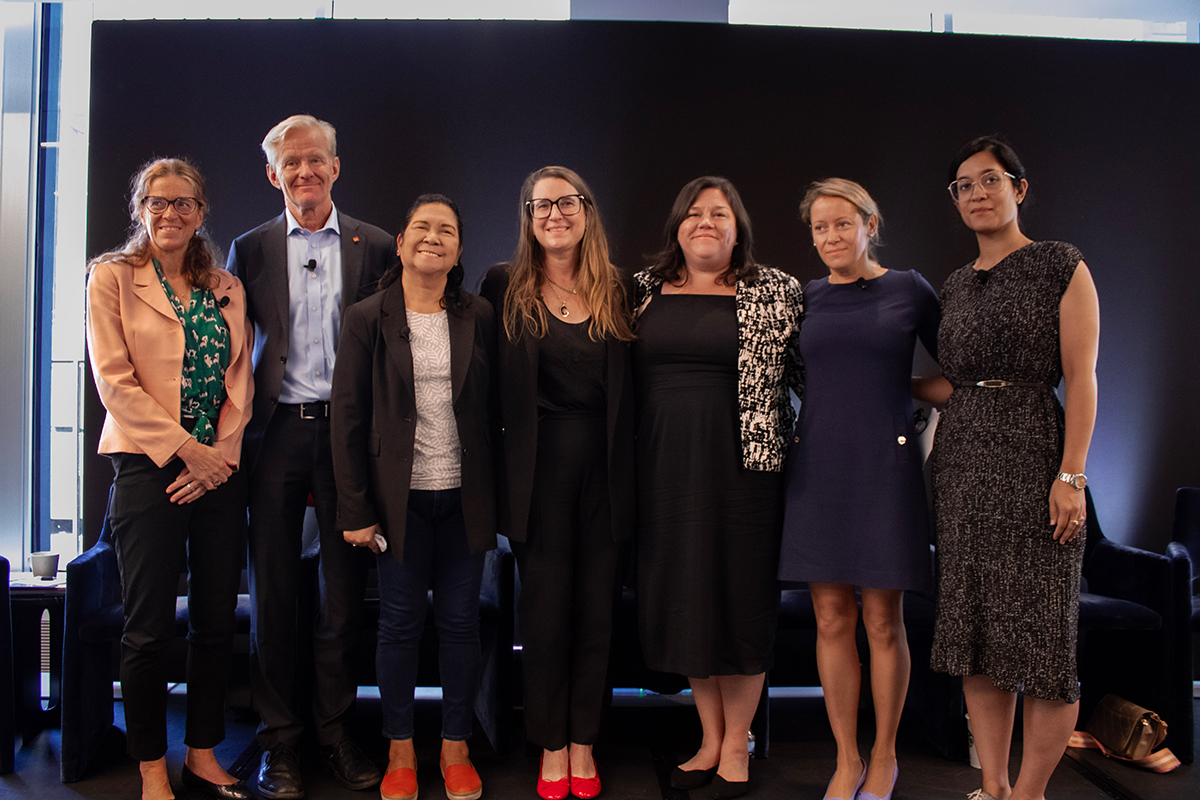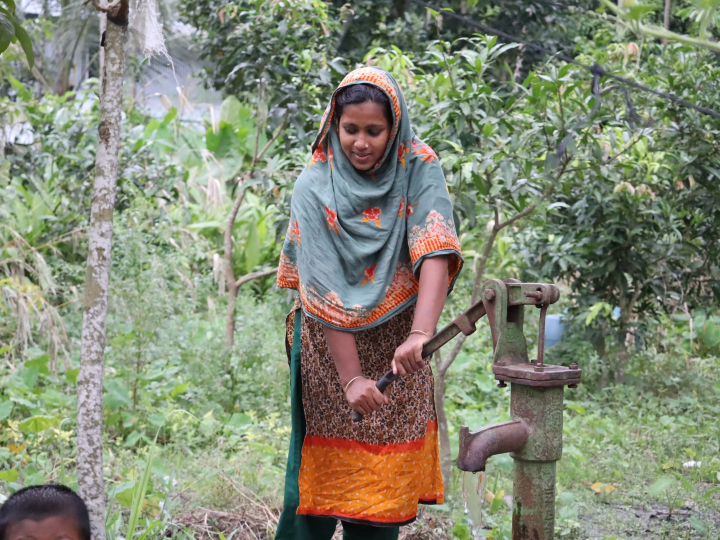The humanitarian sector has been making the case for cash aid for decades. Civil servants, researchers, international non-government organizations (INGOs) and local communities have built credible evidence to show the efficiency and effectiveness of direct cash assistance. But this time, the case we’re making is concerted and urgent. If the humanitarian system as we know it is to reset, then there has never been a better time to center locally led cash.

At the Conrad N. Hilton Foundation, our Disaster Relief and Recovery program takes a cash first approach, investing in this core evidence based intervention across all of the Hilton Foundation’s disaster grantmaking. To support this approach, we must also invest in systems and infrastructure that allow cash to continue to innovate and develop to serve people faster and more efficiently.
This is why the Foundation supports the behind-the-scenes work of the CALP Network, which has been quietly but powerfully advancing locally led cash assistance. CALP has done an outstanding job backing local actors and building the evidence base for cash-first humanitarian response.
I recently joined a CALP panel – Direct by Default: The Most Efficient Way to Do Humanitarian Assistance – alongside colleagues from across the sector. We all shared a similar sentiment: If the evidence is clear, why are we still making the case for cash? Loreine dela Cruz, Executive Director of the Center for Disaster Preparedness and NEAR network member, said it best:
“If the humanitarian reset is to happen, the hard decision is not whether to use cash, but whether we will trust local actors to lead.”
Nearly 75% of the funding within our Disaster Relief and Recovery program is locally led and includes a cash component. We prioritize locally led cash for three key reasons:
My fellow panelists made compelling arguments for locally led cash assistance. These points are worth repeating, not just because they’re backed by decades of research and field insight, but because they offer a path forward in this moment of uncertainty. For funders, it’s a chance to help rebuild a humanitarian system that’s more sustainable, efficient and effective.

Cash is more efficient and effective, especially when it is locally led. With Official Development Assistance slashed, there is increasing pressure for funders and nonprofits to do more with less. Where philanthropy likes to be innovative and catalytic in their approach, the research shows the best steward in crisis is cash.
In 2023, cash assistance made up 85% of humanitarian funding delivered by U.N. agencies and INGOs—a clear sign the development sector recognizes its value. Yet national and local actors, who are closest to the crises, received just 2% of that funding.
Through our Disaster Relief and Recovery program, we support NEAR’s Change Fund, and through our Partnerships team, we fund their Localisation Labs. Both initiatives are designed to shift power and resources to local responders—those best positioned to act quickly and effectively in times of crisis. The Change Fund has built an impressive track record, with local organizations leading response and recovery efforts in some of the world’s most complex emergencies. You can explore their stories on NEAR’s blog—most recently, Local responders lead recovery after Cyclone Remal and floods in Bangladesh by Falastin Omar.
Loreine dela Cruz, Executive Director, Center for Disaster Preparedness and NEAR network member
“Local organizations embedded in communities can see the whole picture and act with the trust and speed that people need.”
We already have the evidence, now philanthropy has the opportunity to play a transformative role in advancing locally led cash assistance. We can shoulder the burden of compliance and due diligence, and challenge the prevailing assumptions around risk. Too often, grassroots organizations are criticized for not meeting compliance standards tied to large grants. But the real issue is structural: we’re not funding the financial expertise—such as chief financial officers or auditors—needed to meet those requirements.
When it comes to due diligence, the humanitarian system’s slow-moving processes can delay funding for months, even as communities are responding to crises in real time. This delay isn’t just inefficient—it’s costly. Fortunately, we now have powerful technological innovations that make cash assistance safer, more secure, and more efficient than ever before.
Twenty years ago, cash assistance meant handing out envelopes. Today, it’s digital money, mobile wallets, remittances and more. Mercy Corps has embraced this shift. Seventy percent of their programs now operate with cash, using a “digital by default” approach that prioritizes safe and efficient delivery, even in the hardest-to-reach places.
Our Disasters program supports Mercy Corps’ work on anticipatory action and other tech-driven innovations that make cash delivery possible in contexts where financial systems have collapsed. According to Kate Phillips-Barrasso, Vice President for Global Policy and Advocacy at Mercy Corps, mobile money is faster, safer and more accountable. It can be delivered even in the toughest environments.
One standout example is their QR-based hybrid system. It allows people to pick up items in stores or digitally cash out, proving that a lack of local currency doesn’t have to be a barrier.
Mercy Corps is also advancing anticipatory action, moving beyond early warning to early response. In Nepal, for instance, when early warning systems flag vulnerable areas for flood, Mercy Corps releases unconditional cash transfers. This enables families to stock up on essentials, safeguard documents, and prepare for impact. It’s not just about surviving the emergency, but also recovering faster.
Kate emphasized that when digital systems are paired with existing technology and data, the potential for digital cash in humanitarian response becomes virtually limitless.
The CALP Network has spent years researching the impact of cash aid in crisis settings. They’ve found when given the choice, communities overwhelmingly prefer cash and voucher assistance. When given a dignified choice, people want the agency to make their own decisions in the face of disaster.
In many Western countries, we rarely think about what it means to lose control over our financial choices. I’ve spent years trying to convince family members that giving people “things” doesn’t work nearly as well as giving them cash. The turning point came during the COVID-19 pandemic. For the first time, many experienced what it felt like to receive humanitarian assistance. As the economy faltered and jobs disappeared, stimulus checks offered a lifeline—and a glimpse into the dignity and flexibility that cash provides in an emergency.
“We’re talking about choice and dignity and that being important, it’s important to get cash in the hands of people to make their own choices.”
Loreine dela Cruz, Executive Director, Center for Disaster Preparedness and NEAR network member
In a moment of upheaval and uncertainty across the humanitarian sector, it might come as a surprise that my fellow panelists expressed a sense of excitement. We’re excited by the growing momentum for funders to embrace and prioritize locally led cash assistance.
Philanthropy has a unique opportunity to lead. By acting as a catalyst and aligning funding streams from both public and private partners, donors can help unlock the full potential of cash assistance.
The evidence is clear. The systems are in place. The local actors are ready. Now it’s time for funders to step up, trust local leadership, and invest in locally led cash-first solutions that meet communities where they are—when they need it most.
Read the full report from CALP Network: The Humanitarian Reset: Less Money – More Cash?